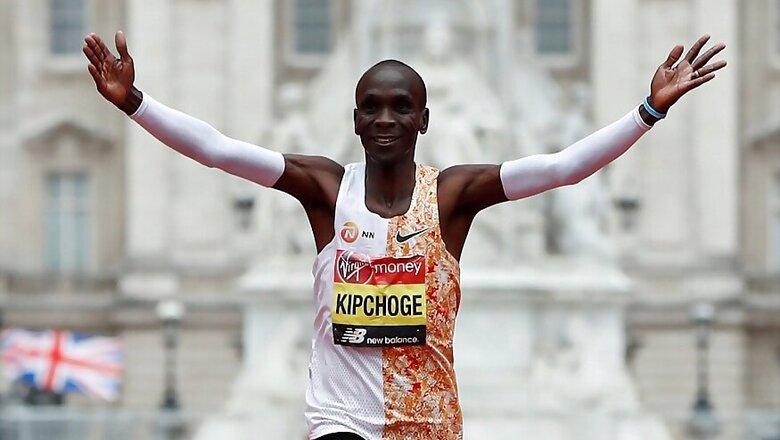
views
Kenyan endurance runner Eluid Kipchoge’s 1:59:40 historic, barrier-breaking marathon race in Vienna (which will go unrecognised because he performed under controlled conditions) is the biggest athletic event or human physical achievement after Roger Bannister ran the mile under 4 minutes in 1954. Kipchoge had the best chance to break the “last barrier of human athletics”, but no one expected it to happen in 2019. And that too ten seconds faster than the projected 1:59:50. Kipchoge’s earlier attempt, on a race track in Italy last year, as part of Nike’s Break2 project failed narrowly —25 seconds over 2 hours. Kipchoge had run in the Delhi half marathon three years back and famously said he did not feel any effect of air pollution.
Kipchoge had threatened to break the 2-minute barrier for two years now ever since he set the world record in Berlin in 2018 of 2:01:39 and then 2:02:37 in London in April. Apart from Nike’s programme, there was the Sub2 marathon project of Brighton University sports scientist Yannis Pitsiladis which also aimed to break the record first. Pitsiladis had said that the timing would be broken at a place which is at sea level, someplace near the Dead Sea probably, since Oxygen is 5% more at sea level. Kipchoge ran in Vienna which was a bit higher than sea level at just over 500 feet.
Pitsiladis, who was not part of the Vienna project, which was managed by oil company Ineos that put in 15 million pounds for it. Kipchoge ran every 100 metres at 17 seconds or just above, and every kilometre at the range of 2:48 minutes to 2:52 minutes; such was the amazing pace. Technology, innovation, commerce and burning desire had everything to do with the Nike-Ineos projects. Everything was planned to perfection, including the arrow-head formation in which top long distance runners would act as his pacemakers, protecting him from wind.
Kipchoge wore Nike’s amazingly advanced Vaporfly shoes which, at the back of this record, is expected to hit the stands next year at around $230 dollars a pair. The footwear and apparel major’s brand name took a hit after the suspension of Alberto Salazar, the main athletics coach in the company’s superhuman Oregon project, over drug-related issues. But it will amble back closer to its comfort zone with the help of Vaporfly and the campaign that follows its release. The shoe has a metallic plate or infusion in the sole which gives a spring to the feet and is yet to be seen whether it will get official clearance for use in competitive sport. Pitsiladis was working on developing just a plaster like layer which would be pasted on a runner’s feet, thus cutting out 20-50 grams of shoe weight.
The larger question that is on top of the mind around the world is how do Kenyans or Africans dominate all forms of athletic running? Many believe that blacks have “the sports gene” in them. This is far from the truth. Pitsiladis had done genetic profiling of about a thousand top runners in Kenya and no such gene was seen. In fact there is nothing more to it than the fact that Kenyan and Ethiopian kids live a physical life, often running and walking over 10 km to school and grazing cattle. But Pitsiladis still believes that the Kenyan Kalenjin people have some sort of an advantage, having grown up in the Rift Valley which is about 9,000 feet above sea level, and so their oxygen carrying capacity has been much enhanced. This is all proof of Swedish psychologist K Anders Ericsson’s famous theory of sustained and deliberate practice being at the root of the creation of super athletes. Other scientists such as Claude Bouchard believe that genetic SNPs (single nucleotide polymorphisms) play a part in VO2 max response (ability to imbibe oxygen or lung power).
Kipchoge, without a doubt, is the healthiest and fittest man on Earth. Science is still wondering about the qualities required to achieve such a feat. Sportswriter Jere Longman estimated that the sub2 effort would require 85 to 90 percent of a runner’s maximum aerobic capacity — twice the capacity of an average man — and a sustained heart rate of about 160 to 170 beats per minute compared to the typical resting rate of 60 to 100. If at all God creates man, the making of Kipchoge must have been a strenuous five-year plan.
Ultimately, there is something beyond science and technology. The great Arctic explorer Ernest Shackleton pointed out the qualities of a great explorer: “First optimism, second patience, third physical endurance, fourth idealism, fifth and last courage.” All this is required of sportspersons too. Kipchoge, of course, has all these boxes ticked. Challengers will find it difficult to match his feat. Especially unless ‘the shoe’ is on the other foot.
(The author is a senior journalist. Views expressed are personal.)


















Comments
0 comment